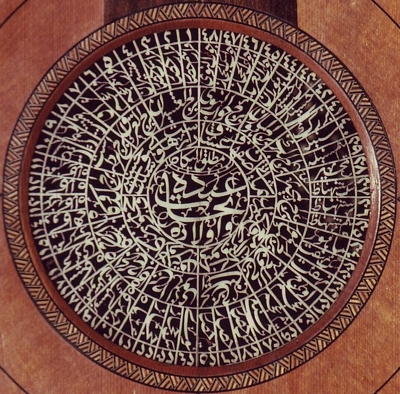Nahhat Ouds

The oldest known Nahhat ouds
Ouds by Ikhwan (Brothers) Nahhat (Abdo and Roufan)
Ouds by Abdo George Nahhat
Ouds by Roufan Nahhat
Ouds by Hanna Nahhat
Ouds by George Hanna Nahhat
Ouds by Antun Nahhat
Ouds by Tawfiq Hanna Nahhat
Nahhat Ouds in Brazil
My most sincere appreciation goes to: Spyros Camateros for research, organizing the information and rewrinting the source code, Livia Jacob for sharing her research on the Nahhat family in Brazil, and Jamil Alfaraby for updating many details about the family history.
Nahhat ouds were made by at least two generations of a family of craftsmen in Damascus, Syria.
Many oudists consider them the finest Arabic ouds ever made.
The tone they produce is unique, sonorous, deep and clear.
The decorative detail and workmanship are unsurpassed to this day.
Additional information has been received from descendants of the family living in Brazil,
Saudi Arabia, Switzerland and Canada who are sharing their memories of the family.
Judging by their first names (George, Antun, Elias, Hanna etc.), the Nahhats were Christian Arabs. The family name came from sculpting or chiseling stone. Yousef Al-Nahhat (George's great grand father), was a stonemason. George (Abdo's father) started in woodworking, while his brothers Elias and Dmitri continued to work as stonemasons along with their father. In the Arabic culture, the first son usually took his paternal grandfather's first name
so all the sons had their father's first name as their middle name.
This makes it possible to trace the family's lineage.
The oldest known maker was George Yousef Nahhat, and he flourished in the early 19th centur.
He had five sons, four of whom followed him in the oud business: Abdo (born around 1860), Roufan, Antun, and Hanna.
The Nahhat brothers initiated their business back in 1880, while their father was still alive (Yousef Nahhat died in 1889). Some reliable contacts in Damascus have been quoted to say they've heard from their fathers that the major Nahhat luthier was actually Rofan, who is the eldest of George's sons, and that he who had taught his brothers the secrets of luthiery: first Abdo and joined as a partner, then later on Antoine and Hanna, who were actually only kids when their eldest brothers launched their new business.
Abdo George was considered by many to be the best of all, and some think of him as the "Stradivarius" of oud
makers. Abdo George had 9 children: Rose 1900, Elias 1902, Fridah 1903, Baseel 1904, George 1907, Niqola 1909, Edma 1911, Cesar 1913, and Juliet 1919. We know that at least three of the boys, George Abdo, Elias Abdo, and Baseel Abdo followed him in the woodworking profession.
In 1935 Bassil and Elias immigrated to Brazil where they started a
furniture making and woodworking business. Abdo, his wife Labibah and the rest of the family followed in 1938.
Unfortunately, it seems that Abdo passed away in Brazil in 1941, without producing any more ouds that are known.
Fortunately, his son Elias Abdo decided to continue the family tradition and created some really beautiful ouds all from 1967 until around 1985. Today there is an Abdo Elias Nahhat living in Brazil, but he is not associated with oud making nor are any other Nahhat family members.
Hanna George Nahhat was born in 1872, and had four sons, Tawfiq Hanna (born in 1896) and George Hanna (born in 1902) followed in the oud business. Joseph (1912-1983) and Antoine (1913-1985) did not work in luthiery.
George Hanna Nahhat produced ouds from the 1920s until about 1962, but it appears he died in 1965
without any male descendants. He had only one daughter, Sonia, who died in Damascus sometime around 2007.
Tawfiq's name and picture appears in several ouds up to the 1930s as well as some
repair labels up to 1946, when he suddenly died at the early age of 50 from a stroke and high blood pressure he had suffered from.
Abdo George's son George Abdo was born in 1907. He lived in Syria until 1938 when
he migrated to Brazil with his father Abdo George.
Judging by the label serial numbers, Oud production was about 4 per month in the early 1800s through the 1920s.
Between 1927 and 1930 this number doubled. The last Nahhat oud was made in 1984 in Brazil, made by Elias Abdo sometimes assisted by his brother George. Several ouds made beginning in the 1910s contain a printed label titled
"Carpentry Shop", advertising "Furniture and Musical instruments" of
"Abdo George Nahhat and Sons", with the picture of Abdo George. None of Abdo's labels has ever insinuated they make musical instruments or ouds. Productivity of the
shop in the late 1920s increased when Abdo's sons joined in and started working with their father.
There were actually two shops producing ouds, one headed by Abdo George, with Roufan, and the other involving
Antun and maybe Hanna. It seems that both Antun and Hanna used to work at the Nahhat Brother's workshop until it broke apart around the middle 1910s. After the Nahhat Brothers partnership was finally liquidated, each brother started making ouds under his own name and label. They both have never made ouds under their own label before the beginning of 1920s. Antoine was about 53 in the early 1920s and Hanna was in his late forties when they started making ouds under their own labels. They were all part of Nahhat Brothers. There is a label with Abdo and Roufan pictured and the shamsiya inscription Ikwan Nahhat,
translated as "Nahhat Brothers". Most other ouds had the individual maker's label, and some included
additional labels at a later date indicating some repair work.
There is no Nahhat producing ouds today. Descendants of the family are living in Syria, Brazil,
Switzerland, Saudia Arabia, Canada and the US. Additional information is hoped to be gained from those
descendants, more oud owners as well as other sources.